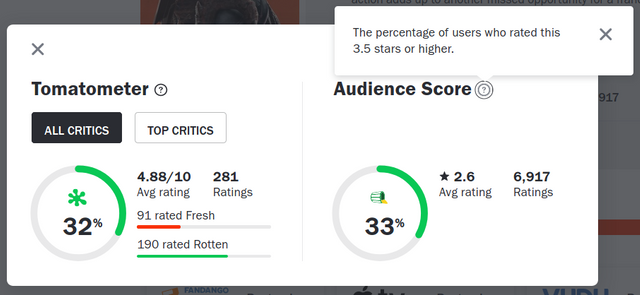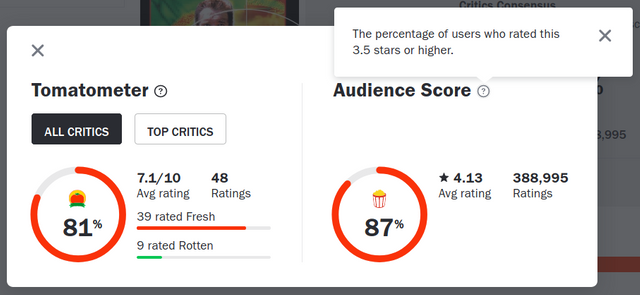Predator Lives Matter
Given the recent Rotten Tomatoes audience score controversies, I no longer put stock in any of their scores. Their Tomatometer score is a contrived platitude from people who do not seem to think much about movies, and definitely think even less of their audience. However, thanks to the Law of Large Numbers, their Audience Score at least had some merit, until recently.

How Rotten Tomatoes scores worked
The Tomatometer score is obtained by polling critics. In theory, hundreds of critics furnish their eligible scores, and a release is certified fresh if more than 60% of the scores are positive. Or if a release consistently scores higher than 75%. Or when at least 5 top critics give it a thumbs up. Or a combination of all of these. There is also a Critics Consensus, which is about as useful as a scientific consensus on any topic.
In practice, there are Rotten Tomatoes curators who can decide what goes into the sausage machine. If you've ever made sausage, you would know the maxim: Garbage In, Garbage Out. I realised something was fishy when a few films generated a huge backlash from fans and enjoyed some online controversy, despite being certified as fresh as a roadkill sausage by Rotten Tomatoes. This is when I started looking at the Audience Score instead.
Initially, the Audience Score seemed to be merely an aggregate of audience scores. I cannot confirm this intuition, but it seemed to me that this is how they worked. Besides the known examples of Rotten Tomatoes trying to do damage control by means of review embargo, such as with Birds of Prey, it seems that the current way of scoring Audience Scores is different.
Audience Scores as a ratio of scores above the 3,5 star threshold
I'm confused by their official explanation, which claims that Audience Scores fall into two categories: A full bucket of popcorn, or a tipped over bucket of popcorn. It is claimed there that a full bucket of popcorn is obtained when at least 60% of users give a rating of 3,5 stars or higher, and a popcorn spill denotes at least 60% of users giving it a lesser rating. However, on the scores on a specific film, the explanation is slightly different.
Take for example The Predator, the 2018 remake. Not to be confused with Predator, the 1987 real deal.

On there, it is claimed that Audience Scores represent the percentage of users who rated the film 3,5 stars or higher. This is a much different requirement from at least 60% of users rating 3,5 stars or higher. Regardless, note the difference between the Audience Score, and the Average Rating in both those instances.
For Predator, it makes sense that an average rating of 4,13 stars would translate into an Audience Score of 80% or higher. It also makes sense that this score is higher than the Tomatometer score, given that critics are usually dropouts from the visual arts or other more practical departments, and end up in the strictly theoretical departments, where they get indoctrinated into Critical Theory - what an appropriate description! This allows them to become wounded lions licking their wounds in resentment while dishing out liberal scorn on anyone who has successfully made it into the world of applying working Film Theory.

For The Predator, the average rating is 2,6 stars. This would translate to an aggregate score of roughly 56% or so, and not the 33% one sees there. Such a rating does make sense if fewer than 60% of the audience rated higher than 3,5 stars, or when only 33% of the audience rated higher than 3,5 stars. But that means an average film is given a sub-par rating of only 33%, whereas it's closer to 56% on the aggregate.
Why did they change their system?
It appears that they changed their system to align the Audience Score with the Tomatometer score, in order to make their film critics appear less out of touch with the dwindling number of people who still bother paying for film tickets. I mean if you really wanted to know whether a film is worth watching, you could just see its download rates on torrent sites over time, but mentioning that kind of objective data is almost as verboten as mentioning the names Harvey Weinstein or Jeffrey Epstein in the same breath as their countless Hollywood beneficiaries.
Every man and woman is a star-studded celebrity film critic
We're just not meant to know our opinions when they don't conform to the opinions of the anointed film critics, or their paedowood masters. For the time being, the average audience score still appears to be useful, but the truth, as Oscar Wilde once quipped, is rarely pure and never simple. No doubt the truth will be blemished sooner rather than later, and a simple aggregate of scores would either disappear entirely, or be so convoluted in layers of other requirements that its simplicity would be lost for all intents and purposes. It's like we say in the biz: Rotten Tomatoes scores are about using data like the drunkard uses a lamppost: Not for illumination, but for support. Meanwhile, Predator lives matter, as we may know from their largely peaceful protests.